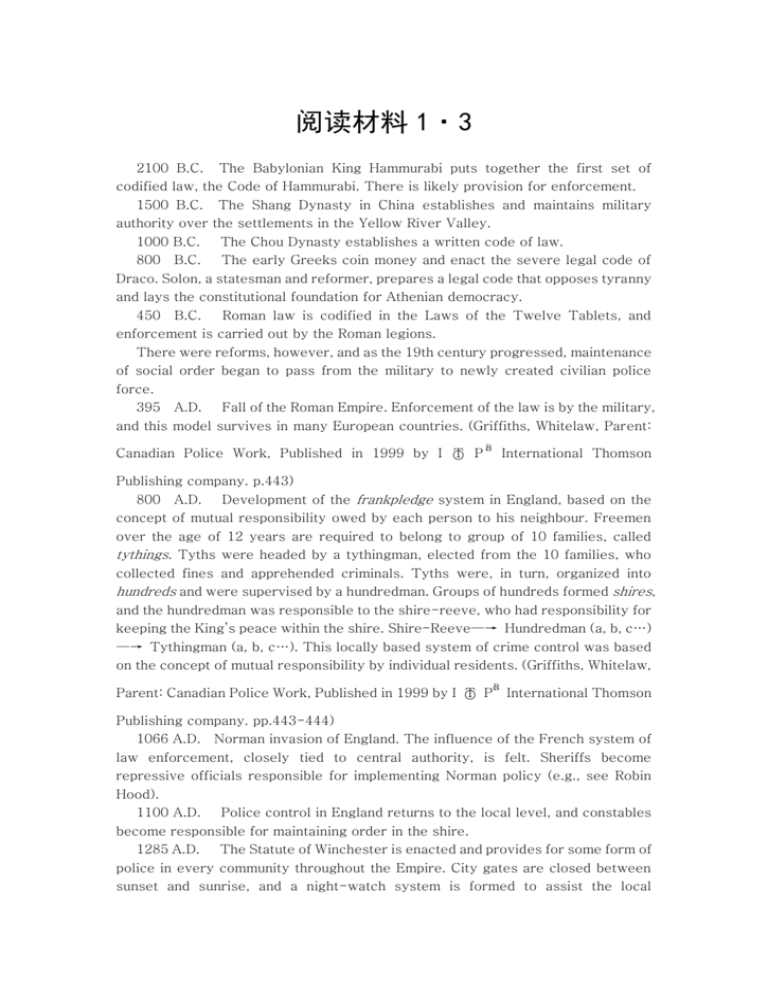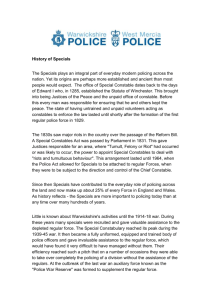阅读材料1•3
advertisement

阅读材料 1·3 2100 B.C. The Babylonian King Hammurabi puts together the first set of codified law, the Code of Hammurabi. There is likely provision for enforcement. 1500 B.C. The Shang Dynasty in China establishes and maintains military authority over the settlements in the Yellow River Valley. 1000 B.C. The Chou Dynasty establishes a written code of law. 800 B.C. The early Greeks coin money and enact the severe legal code of Draco. Solon, a statesman and reformer, prepares a legal code that opposes tyranny and lays the constitutional foundation for Athenian democracy. 450 B.C. Roman law is codified in the Laws of the Twelve Tablets, and enforcement is carried out by the Roman legions. There were reforms, however, and as the 19th century progressed, maintenance of social order began to pass from the military to newly created civilian police force. 395 A.D. Fall of the Roman Empire. Enforcement of the law is by the military, and this model survives in many European countries. (Griffiths, Whitelaw, Parent: Canadian Police Work, Published in 1999 by I ○ T P R ○ International Thomson Publishing company. p.443) 800 A.D. Development of the frankpledge system in England, based on the concept of mutual responsibility owed by each person to his neighbour. Freemen over the age of 12 years are required to belong to group of 10 families, called tythings. Tyths were headed by a tythingman, elected from the 10 families, who collected fines and apprehended criminals. Tyths were, in turn, organized into hundreds and were supervised by a hundredman. Groups of hundreds formed shires, and the hundredman was responsible to the shire-reeve, who had responsibility for keeping the King’s peace within the shire. Shire-Reeve—→ Hundredman (a, b, c…) —→ Tythingman (a, b, c…). This locally based system of crime control was based on the concept of mutual responsibility by individual residents. (Griffiths, Whitelaw, R ○ Parent: Canadian Police Work, Published in 1999 by I ○ T P International Thomson Publishing company. pp.443-444) 1066 A.D. Norman invasion of England. The influence of the French system of law enforcement, closely tied to central authority, is felt. Sheriffs become repressive officials responsible for implementing Norman policy (e.g., see Robin Hood). 1100 A.D. Police control in England returns to the local level, and constables become responsible for maintaining order in the shire. 1285 A.D. The Statute of Winchester is enacted and provides for some form of police in every community throughout the Empire. City gates are closed between sunset and sunrise, and a night-watch system is formed to assist the local constables. The hue and cry, whereby constables can literally call on citizens for assistance, is defined as a community police duty. 1361 A.D. The Justice of the Peace Act is enacted, centralizing peacekeeping duties under justices of the peace. While the Statute of Winchester had made policing a responsibility in towns, under the JP Act, justices of the peace had a higher status than constables. This is the first instance in which there was police subordination to the judiciary. 1500 A.D. With the growth of trade and industry, residents of the shires begin avoiding their duty to serve as constables. The unemployed and uneducated are hired by residents to serve in their place and are given policing tasks. 1748 A.D. Henry Fielding, a justice of the peace in London, makes an attempt at law enforcement with the Bow Street Runners. 1800 A.D. The tything system, hue and cry, town constables, and justices of the peace are ineffective in coping with the rise in crime that accompanies the Industrial Revolution. Justices of the peace are corrupt and constables are inept. London is one of the worst policed cities in Europe. (Griffiths, Whitelaw, Parent: Canadian Police Work, Published in 1999 by I ○ T P R ○ International Thomson Publishing company. p.444) In 1805, Sir Richard Ford became Chief Magistrate of Bow Street. He took vigorous steps to end the crime in and around London. Ford received permission to revive the mounted horse patrols to guard the main roads into London. He recruited sixty men, most of whom were cavalry veterans, for the renewed Mounted Police Unit. These men, a highly motivated and elite troop, gained international fame as the “Bow Street Runners.” Their “Bow Street Patrol” greeting reassured those travellers who dared to use the dangerous highways surrounding the great city. 1822 A.D. Sir Robert Peel sets out to reform the police. Modern policing is based on principle first set out in England in the early 1800s. The first organized police force was created in London, England. The 1829 Metropolitan Police Act, which established the Metropolitan London Police, was passed in the face of opposition by a public fearful of the power and authority that would be vested in a formal police agency. This police force was under the direction of Sir Robert Peel, and the constables became known as Peelers or Bobbies. In an attempt to reduce public suspicion and distrust of the police, recruitment criteria were established and constables were selected from local community. Peel also introduced the idea of establishing police stations throughout the community.








